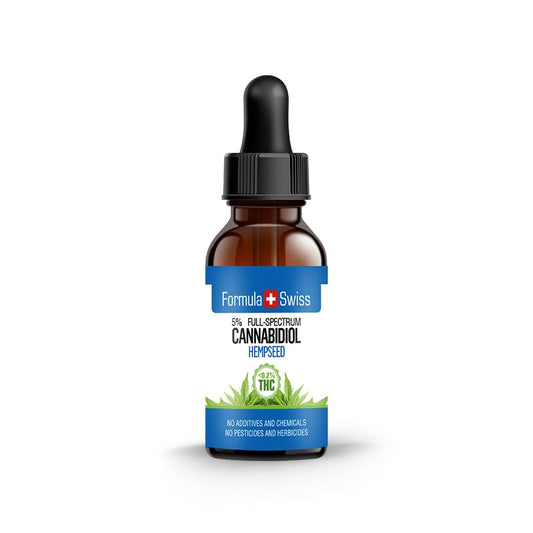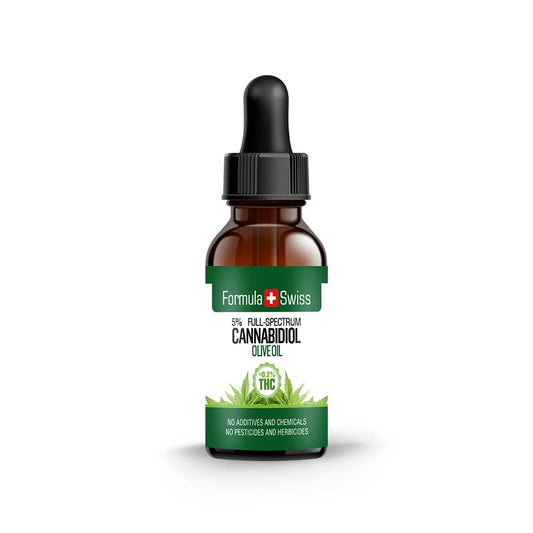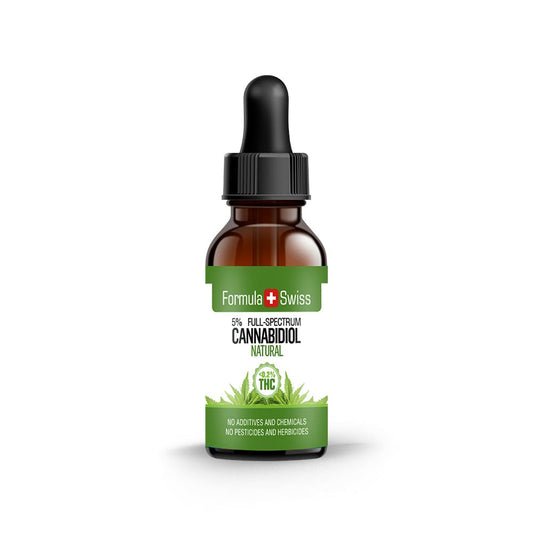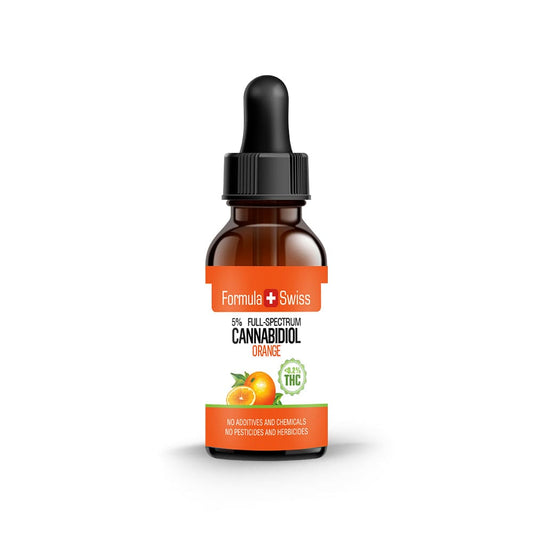CBN, short for cannabinol, shows up in cannabis when THC starts to break down. It’s only found in small amounts and isn’t as strong as THC, but it still plays a part in the plant’s overall mix of compounds. Most people haven’t heard much about it, which is a shame, really.
I didn’t pay much attention to CBN at first either. It wasn’t until I started working more closely with cannabinoid profiles at Formula Swiss that I began noticing how often it popped up. Over time, it became one of those compounds I kept circling back to. It’s not just that it’s different, but also that it’s often misunderstood or simply left out of the conversation.
Compared to the big names like THC and CBD, CBN behaves in its own way. It’s milder, yes, and it interacts with receptor systems in a manner we’re still learning about. That sort of complexity is what keeps me curious.
I try to follow the latest developments and share what I learn in a way that’s clear and honest. There’s plenty of noise out there, especially when it comes to cannabinoids that aren’t in the spotlight. Drawing on real, hands-on experience helps make sense of it all, and I think that’s what more people are starting to look for.

Key takeaways
- CBN (Cannabinol) is a non-psychoactive cannabinoid found in the cannabis plant, which contains over 100 known cannabinoids.
- CBN is distinct from THC and CBD, with unique interactions with the body’s receptors and different characteristics.
- CBN is currently being studied for its interactions with the body's systems, with research exploring various potential effects.
- Research into CBN remains limited compared to CBD, presenting opportunities for further scientific study.
- Understanding the nature of CBN can support individuals in making informed decisions when exploring cannabinoid products that align with their preferences.
This article is provided for informational purposes only and does not relate to any of the products available in our webshop. For more information, please see our full disclaimer.
CBN and its place in the cannabis family
Having spent considerable time researching cannabinoids, Cannabinol (CBN) stands out as a minor cannabinoid but fascinating compound compared to the more widely recognised tetrahydrocannabinol (THC) and cannabidiol (CBD).
CBN forms naturally as THC in the cannabis plant ages and is exposed to air, light, and heat. Over time, this leads to a compound estimated to be about 25% as active as THC.
I find the mild nature of CBN particularly interesting. Unlike THC, it does not produce psychoactive effects, giving it a unique position within the cannabinoid family. Although interest in CBN has been growing, the availability and variety of CBN products still trail behind those of CBD.
Research into CBN continues to evolve. Its role within the wider study of cannabis compounds reflects a broader shift towards understanding non-psychoactive cannabinoids in more detail.
Here’s a brief summary of some key cannabinoids and their commonly associated characteristics:
| Cannabinoid | Psychoactive | Effects |
|---|---|---|
| THC | Yes | Euphoria, appetite stimulation |
| CBD | No | Relaxation, calmness |
| CBN | No | Milder characteristics compared to THC |
Knowing more about the primary cannabinoids found in cannabis helps provide a From what I have seen, gaining a clearer understanding of the main cannabinoids in cannabis helps build a stronger appreciation of how CBN fits into the overall profile of the plant.
Although CBN remains less well-known compared to THC and CBD, interest in its unique properties is steadily increasing as research continues to explore its potential uses.
CBN’s non-psychoactive profile, together with its distinct characteristics, differentiates it from other cannabinoids and continues to attract attention as a plant-derived compound of interest.
How CBN differs from THC and CBD
CBN naturally forms in the cannabis plant as THC ages and degrades, particularly when exposed to heat, air, and light. This process results in a compound generally considered less potent than THC.
Unlike THC and CBD, CBN develops through the breakdown of another cannabinoid, giving it a distinct place within the cannabis family.
Browse our selection of CBN oils
The natural formation of CBN from THC
CBN naturally forms when THC, the primary psychoactive compound in cannabis, degrades over time. Exposure to heat, light, and air accelerates this transformation, resulting in CBN, a cannabinoid with much lower psychoactive potential.
This natural process creates distinct differences in the chemical structure and characteristics of CBN compared to THC and CBD.
What is THC (Tetrahydrocannabinol)?
Comparing CBN, CBD, and THC
THC is widely recognised for its psychoactive effects, while CBD and CBN have drawn attention for their properties without significantly altering mental state. Although CBN at higher concentrations may produce mild psychoactive responses, it remains much less potent than THC.
Unlike THC, which directly activates cannabinoid receptors, both CBN and CBD influence these receptors indirectly, resulting in differing characteristics across the cannabinoids.
| Cannabinoid | Effect on receptors | Notable characteristics |
|---|---|---|
| THC | Direct engagement | Recognised for its uplifting effects, association with sensory experiences, and influence on overall mood |
| CBD | Indirect influence | Commonly linked to a sense of calm, often chosen for its role in daily relaxation routines |
| CBN | Indirect influence | Frequently explored for its gentle, soothing qualities and its connection to plant-derived balance |
Research into CBD is more extensive compared to CBN, with studies exploring its interactions with the body's systems and its broader contribution to wellbeing.
Prefer watching over reading? This video covers the key points from the article:
Interest in the potential of CBN
Although research on CBN remains less extensive than studies on CBD, early investigations have raised interest in how this non-psychoactive cannabinoid may interact with the body's natural processes.
Among the cannabinoids I have explored, I find CBN particularly fascinating because of its unique characteristics and the distinct ways it interacts within the broader cannabinoid profile. Its properties set it apart from CBD and THC, making it an area of keen scientific interest and continued research.
In this section, I will share areas where research findings suggest that further investigation into CBN may be worthwhile.
Associations between cannabinol and rest
Several studies have examined how CBN interacts with other cannabinoids, particularly THC, in relation to its unique properties. Based on the available research, there are indications of a relationship between CBN and natural rest cycles, though further investigation is required to understand this interaction in greater detail.
CBN and physical comfort
Research has also investigated how CBN interacts with the body’s receptors, generating interest in its distinct interactions and potential applications within cannabinoid studies. I find this area particularly promising, as it highlights how minor cannabinoids like CBN may contribute to broader plant-based wellness discussions, even though more comprehensive research is needed.
Cognitive support and CBN
A 2022 study from Salk has explored CBN’s interaction with nerve cells, indicating a possible role in neurological research. Although these findings are preliminary, they highlight an important direction for future studies focused on non-psychoactive cannabinoids.
Scientific interest in cannabinol and relaxation
The properties of Cannabinol (CBN) have attracted attention in recent years, particularly in discussions about relaxation and rest. Products containing CBN are now available on the market, often combined with other ingredients associated with calming experiences.
Despite its growing popularity, questions remain about CBN's specific role and how it interacts within these formulations. Scientific research continues to explore its distinct characteristics and potential applications.

CBN and its association with natural rest
Scientific interest in CBN’s potential role in supporting rest dates back to studies from the 1970s and 1980s, where researchers noted calming effects, particularly when CBN was combined with THC.
However, these studies were limited in size and scope, and further research is needed to better understand the extent of CBN's potential associations with natural rest patterns.
Recent research has also begun to explore ongoing studies examining CBN and sleep patterns. A study published in Neuropsychopharmacology found that CBN increased both REM and non-REM sleep in rats, offering early evidence of its sleep-related properties.
A pilot clinical trial known as the CUPID study is also underway to assess the effects of CBN on sleep and next-day functioning in individuals with insomnia disorder.
From my experience following developments in cannabinoid research, I have observed that CBN is often associated with relaxation in popular discussions and remains a topic of ongoing scientific investigation. Although early findings are promising, substantial evidence is still required to confirm CBN’s role in promoting rest.
Today, a variety of products feature CBN alongside other ingredients traditionally associated with relaxation. These often include combinations of CBN with natural botanicals known for their calming properties, such as:
| Natural ingredient | Description |
|---|---|
| Melatonin | A hormone produced by the pineal gland, often involved in sleep-wake cycle studies. |
| Valerian root | A herb historically used to encourage relaxation and support natural rest. |
| Lavender | An essential oil commonly associated with calming and soothing effects. |
| Chamomile | A widely-used botanical, often enjoyed as a tea, linked with feelings of relaxation and ease. |
Although anecdotal reports suggest an association between CBN and rest, further clinical research is necessary to strengthen these observations.
View our range of CBN oil products
Scientific interest in CBN and physical comfort
Scientific investigations have suggested that CBN may influence muscle sensitisation responses in animal models. A well-regarded study featured in the Archives of Oral Biology examined how non-psychoactive cannabinoids, such as CBN, affect muscle sensitivity in rats.
In this study, researchers created muscle sensitivity by introducing nerve growth factor (NGF) into the masseter muscle, replicating conditions similar to those seen in TMD. Following this, they delivered intramuscular injections of CBN, cannabidiol (CBD), as well as a combination of both.
The results showed that CBN and CBD, whether used separately or together, effectively reduced mechanical sensitivity in the masseter muscle. These observations indicate that CBN could influence peripheral responses in muscle discomfort models.
Although studies combining CBN with CBD have indicated possible complementary effects, comprehensive human clinical trials are still necessary to better understand how CBN interacts with the body’s natural systems relating to nerve and muscle responses.
From what I have observed in emerging research, CBN’s association with physical ease is a promising area for future study, but definitive conclusions cannot yet be drawn.
Based on what I have seen, it is likely that as awareness of cannabinoids like CBN continues to grow, researchers will expand investigations into how these compounds might support physical well-being. However, human clinical trials will be essential to confirm early observations and ensure a fuller understanding of CBN’s characteristics.
Risks and side effects of CBN

Research into CBN remains at an early stage, and the full extent of its safety profile has yet to be established. Compared to CBD, whose potential side effects and interactions with other substances have been more thoroughly documented, information regarding CBN’s effects is still emerging.
Given the current state of cannabinoid research, I believe it is important to approach new compounds like CBN with caution until more comprehensive data becomes available. While CBN is often described as non-psychoactive, high concentrations could potentially lead to mild psychoactive responses.
Individuals considering CBN as part of their wellness routines are advised to consult a qualified healthcare professional, particularly due to the possibility of interactions with other medications or underlying health conditions.
Below is a summary of the currently known side effects and potential risks associated with CBN and other cannabinoids:
| Compound | Potential side effects | Potential risks |
|---|---|---|
| CBN (Cannabinol) | Not well-established; mild psychoactive effects possible at higher concentrations. | Possible interaction with medications; long-term safety profile remains unclear. |
| CBD (Cannabidiol) | May include dry mouth, dizziness, digestive changes, or reduced appetite. | Documented interactions with certain medications; high doses linked with liver enzyme changes; caution advised during pregnancy and breastfeeding. |
| THC (Tetrahydrocannabinol) | May cause altered perception, drowsiness, and increased heart rate. | Associated with dependency risks, cognitive impairment, and cardiovascular concerns with prolonged use. |
Considerations around CBN usage

Current knowledge around appropriate quantities of CBN is still evolving, and no formal guidelines have yet been established. As research continues to develop, it is recognised that individual responses to cannabinoids may vary.
It’s always sensible to consult a healthcare professional before adding cannabinoids like CBN to your routine, especially with research still evolving. Considering personal health circumstances, existing treatments, and individual needs can support informed and balanced decisions.
Although scientific frameworks for CBN are still emerging, taking a thoughtful and personalised approach helps ensure that exploration of cannabinoids is considered carefully, with individual differences in mind.
Ongoing CBN research
While there are still gaps in scientific knowledge surrounding CBN, interest in understanding this cannabinoid continues to grow across both research communities and the public sphere.
Current studies are working to better define CBN’s characteristics, including its individual properties and how it interacts with other cannabinoids and terpenes. As scientific investigations progress, it is expected that the body of evidence surrounding CBN will expand, offering further insights into its potential applications.
Recent statements from respected authorities further highlight this growing interest. For example, the U.S. National Institutes of Health (NIH) has encouraged research into the biological properties of minor cannabinoids, including CBN, particularly in areas such as pain and neurological conditions (NIH Notice NOT-AT-22-027).
Similarly, the U.S. Food and Drug Administration (FDA) has recognised the importance of gathering scientific data on cannabinoids like CBN to inform future regulatory considerations (FDA Cannabis-Derived Products Data Acceleration Plan).
Interest in cannabinoids more broadly has increased significantly in recent years, and CBN has become a part of this growing focus. Researchers are exploring not only CBN’s standalone features but also its role within the wider cannabinoid and plant compound profile.
Future findings may provide a deeper understanding of how CBN fits into the broader study of cannabinoids. However, further research will be key in shaping how CBN is considered in various contexts moving forward.
From what I have observed, it is important for those interested in cannabinoids to stay informed about ongoing research developments. As knowledge expands, careful attention to safety and quality remains essential when considering any cannabinoid-based products.
Personal perspective
Based on what I’ve observed in recent cannabinoid research, interest in CBN has been gradually gaining traction. While it remains less prominent than THC or CBD, more researchers are now examining its individual characteristics and how it contributes to the broader chemical profile of the cannabis plant.
Although much is still unknown, I believe that continued scientific exploration will offer a clearer understanding of how CBN functions. It has been encouraging to follow this progress. It reinforces the importance of measured research, careful analysis, and clear, responsible communication when discussing cannabinoids and their place within ongoing developments in the field.
Frequently asked questions
What is CBN?
CBN, or Cannabinol, is a naturally occurring cannabinoid found in the cannabis plant. It forms as a result of the gradual breakdown of THC through a process called oxidation, often influenced by exposure to air, light, and heat.
How does CBN differ from CBD and THC?
CBN differs from CBD and THC in both its chemical structure and characteristics. While THC is known for its psychoactive effects, CBN and CBD are generally described as non-intoxicating under typical conditions. However, CBN, when present at higher levels, may be associated with mild psychoactive responses. Unlike CBD, which does not produce psychoactive effects, CBN is considered less potent than THC, with an estimated activity of around 25% relative to THC.
Is CBN psychoactive?
CBN is considered mildly psychoactive, though significantly less so than THC. In larger concentrations, CBN may be associated with subtle psychoactive responses, but it does not typically produce the strong effects associated with THC.
What is currently known about the potential properties of CBN?
While CBN has not been studied as extensively as CBD or THC, early research has examined its characteristics and possible associations with areas such as natural rest patterns and physical comfort. However, comprehensive human studies remain limited, and further scientific investigation is needed to clarify its potential applications.
How is CBN produced and obtained?
CBN forms naturally as THC oxidises over time when exposed to air, light, or heat. CBN can be separated from the cannabis plant using extraction methods such as CO₂ extraction or solvent-based techniques, similar to processes used for other cannabinoids.
Are there any side effects or risks associated with CBN?
The safety profile of CBN is still being developed. While some preliminary studies suggest CBN may influence feelings of relaxation or sedation, comprehensive research into side effects remains limited. It is important for individuals to consult qualified healthcare professionals before considering cannabinoid-based products, particularly in the context of existing health conditions or medications.
How does CBN interact with the endocannabinoid system?
CBN is believed to interact with the endocannabinoid system by engaging with CB1 and CB2 receptors, which are found throughout the body. CB1 receptors are mainly located in the brain and nervous system, while CB2 receptors are more prevalent in the immune system and peripheral tissues. However, the exact nature of CBN's interaction with these receptors continues to be an area of active research.
Are there any ongoing research studies on CBN?
Research into CBN is ongoing, with scientific studies exploring its individual characteristics as well as its interactions with other cannabinoids and plant compounds. As interest in minor cannabinoids increases, future studies are expected to provide more insights into the potential roles and applications of CBN.
What types of CBN products are currently available?
CBN products are less widespread compared to CBD products, but can be found in various formats. These include oils, topicals and isolates. As research evolves, the availability of CBN products may expand in accordance with safety standards.
Learn more about CBD, one of the most well-known cannabinoids






